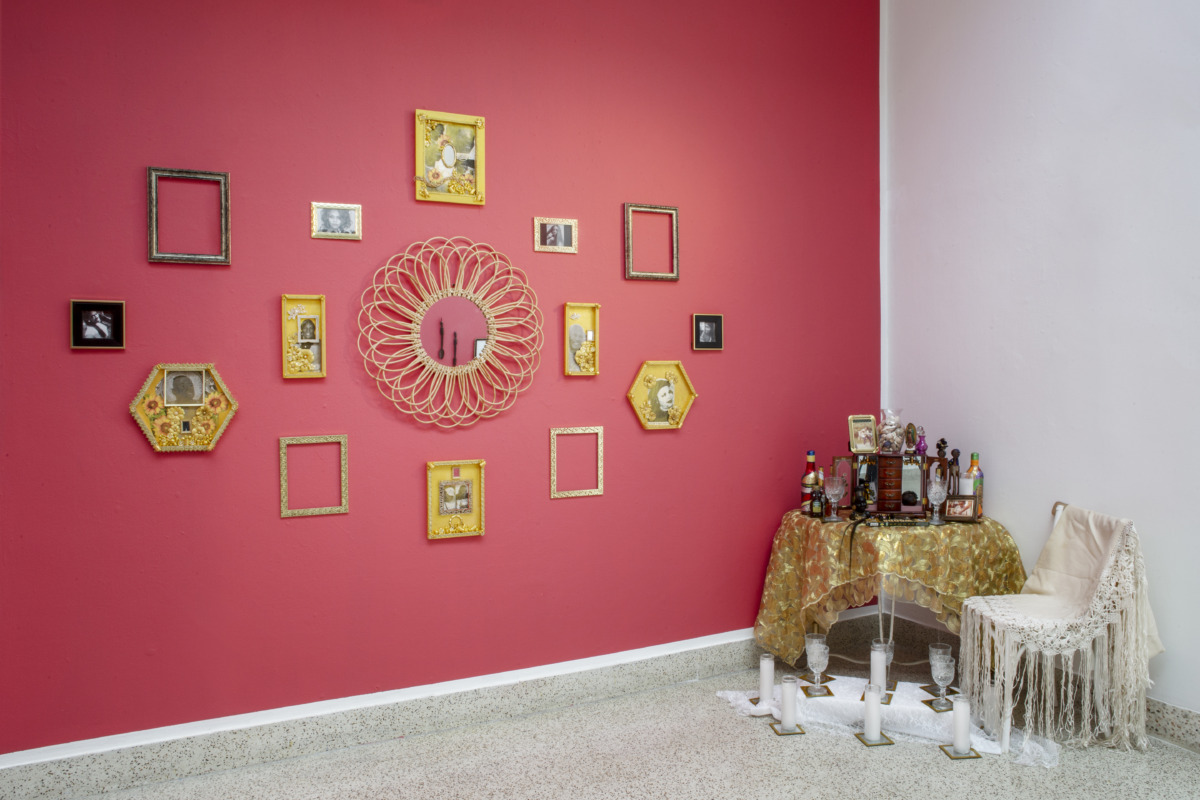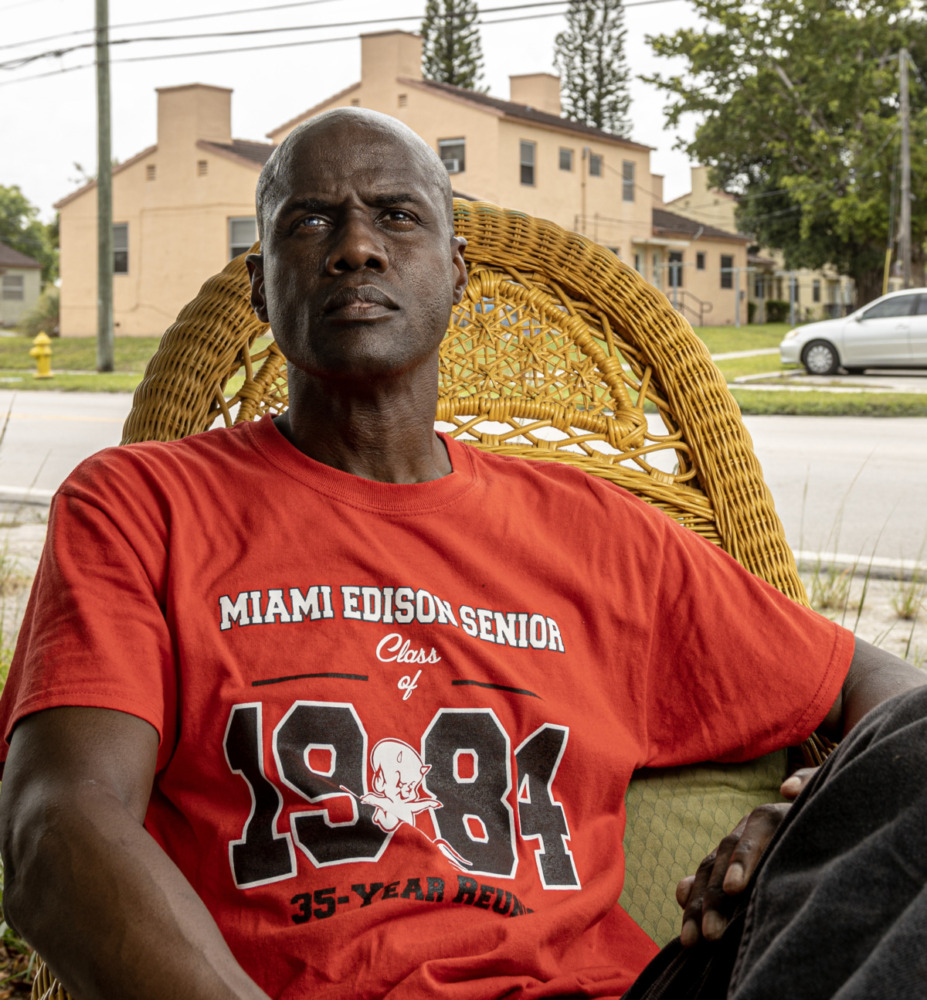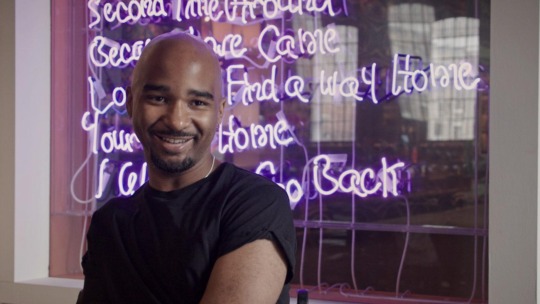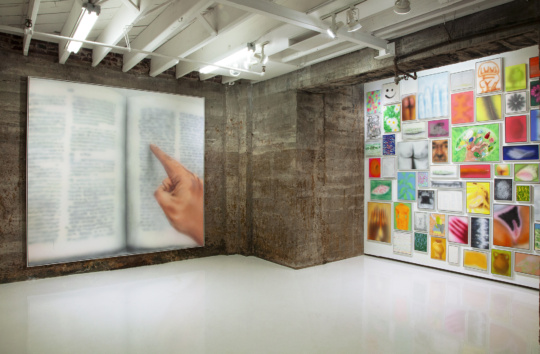
When I walked into Miami’s Little Haiti Cultural Center to see Give Them Their Flowers: An Exhibit of Black LGBTQ+ Miami History, a very helpful staff member asked me, “Where are you from?” It’s a query which can be loaded and anxiety-inducing, but in this context–surrounded by images, items, and stories of what could be my family or friends–it made me feel at home. Where am I from? The Black Queer Caribbean Diaspora of Miami.
Give Them Their Flowers illuminates the previously hidden stories of Miami’s Black LGBTQ+ community. Participating artists in the show include Vanessa Charlot, Woosler Delisfort, Kendrick Daye, Hued Songs, and Loni Johnson. Along with Marie Vickles, the show was curated by local historian and founder of Black Miami Dade Nadege Green. “Miami is a place that likes to reinvent itself over and over and over again,” Green told me. “Who gets to tell the stories, who gets to take up space, can be contested. Black, Queer stories can be made invisible. These stories, this exhibit, wholly reject that invisibility.”
The exhibit—a mix of personal stories, cultural practices, and archival information—is divided into three sections: Living Memory which focuses on the present, Been Here which focuses on the past, and the final section entitled The Repast. You’re greeted by a wall of flowers when you enter the space. It’s the first indication of the show’s ever-present joy. “Anytime we are telling our stories, we are inviting people to remember or re-remember,” Green said.
Portraits and interviews of living Black, Queer folks with ties to Miami are on display in Living Memory. One is a photo taken by Vanessa Charlot of former WNBA player and Miami native, Tracy Reid, hanging next to her Charlotte Sting jersey. There’s also a video interview of 69-year-old retired anthropologist Naomi Ruth Cobb describing her first brushes with the queer community growing up in Liberty City. This section is vital because–in a state where these stories have been kept hidden by design–we finally have the opportunity to document in real time. We’ve had to cobble together stories of Black, Queer pasts. In many cases, these stories were either passed down orally or disappeared with the storyteller. “300 people came on opening night,” Green said. “They were like, ‘I don’t have access to Queer elders, I never had access to a Queer elder,’ so to be in a space not only with one but many, to be in the presence of someone who is older than you and Black and Queer and from Miami, we don’t get those types of intergenerational spaces often.”

As I was looking at the portraits, I was continually struck by the aforementioned joy. As Black, Queer folks, we are familiar with the negativity that can come with coming out. Rejection is still a very real possibility for many Black LGBTQIA+ people within Black communities and families. These factors combined with an antagonistic Floridian political environment don’t exactly inspire joy. “Choosing your joy when you live in a racialized and unfairly sexualized body is a deliberate decision,” photographer, journalist, and professor Vanessa Charlot said. “They had to find a way to find peace and make sense of their own life, in order to not just survive but to thrive.”
There are joyous moments of Queer love, like wedding photos of couple Federica Dawson and Barbara Horne, both dressed in white in front of a backdrop of Greek columns and red velvet. There are also narratives of Queer community and acceptance, like Cobb’s recollections of the neighborhood “dapper women” and drag queens that performed at a community hangout and dance hall called The Pool. “I wanted the viewer to have a window into the innermost part of this person,” Charlot said. “I wanted for their presence to pierce that veil, they are not just behind the scenes, they are a part of Miami––period.”
The exhibit includes a photo of Ned Nottage by Woosler Delisfort. I connected with the photo of a kind-faced, but unsmiling Black man in a wicker chair immediately. He could be my father, grandfather, or uncles. As I read the accompanying quote from Nottage, I was overwhelmingly touched.

“My mother, my junior year in high school, sat me down and we had that talk about nature and her concern was that I did not become a teenage parent . . . In the back of my head, I was thinking. ‘That is not going to happen. You don’t have to worry about that.’ And then she said to me, ‘Son, are you gay?’ And I was so shocked she actually came out and asked me that. And I looked at her, and I think I wanted to cry because I was her oldest. I said to her, ‘Mom, yes I am. Are you upset about that?’ And she says, ‘No baby. Mama’s not upset.”
When I was a junior in high school, I had the same conversation with my Jamaican mother. It was amazing that someone else could have such a similar experience and I was so grateful to know that his was as loving as mine had been. Our stories of love, community, and acceptance should be seen and heard as much as our stories of loss.
In Living Memory, there are newspaper clippings, such as a write up on Josephine Baker’s demand for integrated shows in Miami. In 1951, Baker famously said “I cannot work where my people cannot go. It’s as simple as that.” On opening night, Baker told the integrated Miami Beach audience at the Copa City Club in Miami Beach, “I am happy to be here and to be performing in this city under these circumstances when my people can be here to see me.”
In addition, there are pieces on the famous “male impersonator,” Stormé DeLarverie, reversible plush dolls of Flip Wilson and his alter ego Geraldine Johnson, and posters for the “female impersonator,” Pick Pocket Pearl; “The most curious act ever been to Jamaica.” Pearl is thought to be the inspiration behind Wilson’s Geraldine character.
There are images of ordinances, arrests, posters, and articles featured in this section; A 1977 piece in the Miami Times reads, “Discrimination of any kind can’t be condoned. Black people shouldn’t be endorsing any policy that discriminates. Homosexuals have a right to earn a livelihood.” This merging traditional historical records and oral histories creates a bricolage that replicates the patterns of our memories.
In The Repast, the final section of Give Them Their Flowers, the overwhelming feeling of shared experience persisted; even though losing loved ones is sad, there’s comfort and beauty in how Black folks celebrate their dead. After a burial, Black folks gather at the repast to share memories and stories about the deceased. The bright, colorful room is filled with African spiritual totems, Virgin Mary figurines, and a statue of Yoruba Goddess Yemaya. The “repast” honors the cultural mixing and recreating Black folks do, especially when honoring their dead. Ornate glasses, gold coins, white candles, and Florida water are offerings on the altar of the Black, Queer folks we have lost. Loni Johnson created this installation as a space to honor and mourn Black, Queer folks that have passed away.
In many Black families, there is a room or a space with photos of elders, ancestors, and those gone too soon amongst graduation, wedding, and birthday photos. My grandma’s house is no different. Johnson’s bright pink room captures the happiness that comes with sorrow in these kinds of spaces.
“’Give Them Their Flowers’ is a term you often hear in the Black community,” Green said. “Don’t wait until people aren’t here to tell them how much you love them, don’t wait until people aren’t here to honor them, you’ll hear in a cautionary tone. Sometimes we don’t get to give flowers to the living though. That’s what our repast is for. The idea in our Black spirituality that people are still with us when they’re gone, so it’s never too late.”
The Repast features photos of Black, Queer community members we have lost, like Marion “Flossie” Sheffield, a transgender woman who was murdered in Overtown in the ‘50s. In between their portraits are mirrors. The effect places the viewers amongst those lost and empty frames holding space for unnamed names and faces.
Visitors are encouraged to write a memory of a departed Queer loved one, allowing the viewer and their beloved dead to be a part of the Miami Black, LGBTQ+ community now and forever.
“Someone was writing about a loved one who they felt they did not love enough, or did not show up for enough when they were living,” Green said. “But in this memory book, it is almost like an apology or an ‘I am here now.’”
Through the present, past, and “repast,” Give Them Their Flowers encourages us to honor our Black, Queer friends, family, and loved ones now.
Give Them Their Flowers is on view at the Little Haiti Cultural Center from March 13 through April 23.

This piece was published in partnership with Oolite Arts as part of a project to increase critical arts coverage in Miami-Dade County.




